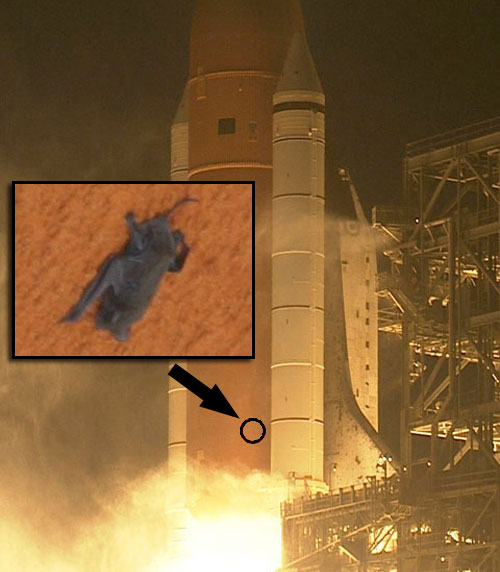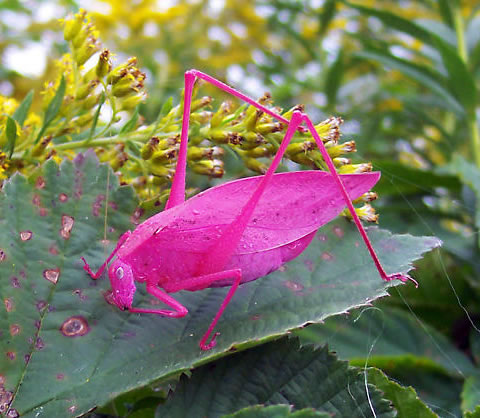“Saber-toothed squirrel” bridges 150 million year gap in fossil record reads an article at ars technica summarizing an article in the journal “Nature”…
All I care is: Skrat lived!

“Saber-toothed squirrel” bridges 150 million year gap in fossil record reads an article at ars technica summarizing an article in the journal “Nature”…
All I care is: Skrat lived!

Posted in Because I Can, Critters
 On March 15, 2009, a small bat that was spotted blasting off with the space shuttle Sunday and clinging to the back side of Discovery’s external fuel tank apparently held on throughout the launch.
On March 15, 2009, a small bat that was spotted blasting off with the space shuttle Sunday and clinging to the back side of Discovery’s external fuel tank apparently held on throughout the launch.
NASA hoped the bat would fly away before the spacecraft’s Sunday evening liftoff, but photos from the launch now show the bat holding on for dear life throughout the fiery ride.
“He did change the direction he was pointing from time to time throughout countdown but ultimately never flew away,” states a NASA memo obtained by SPACE.com. “Infrared imagery shows he was alive and not frozen like many would think … Liftoff imagery analysis confirmed that he held on until at least the vehicle cleared [the] tower before we lost sight of him.”
Officials at NASA’s Kennedy Space Center in Cape Canaveral, Fla., where Discovery launched from a seaside pad, said the bat’s outlook after launch appears grim.
“Based on images and video, a wildlife expert who provides support to the center said the small creature was a free tail bat that likely had a broken left wing and some problem with its right shoulder or wrist,” NASA officials said Tuesday. “The animal likely perished quickly during Discovery’s climb into orbit.”
Because the Kennedy Space Center is also home to Florida’s Merritt Island National Wildlife Refuge, NASA’s launch pads are equipped with several countermeasures, including warning sirens, to ward off birds and other wildlife. NASA also relies on radar to make sure large flocks of birds won’t be struck by the shuttle during liftoff.
But the bat on Discovery’s tank did not budge, even after engine ignition.
The bat was perched between one quarter and one third of the way up on the north side of the fuel tank, which is the side that faces away from the orbiter. NASA estimated the surface temperature of the tank at that location was between 58 and 70 degrees Fahrenheit, even though the canister was filled with super-cold liquid hydrogen and liquid oxygen.
In the hours before Discovery’s liftoff, NASA’s Final Inspection Team (called the “ICE team”) investigated whether the creature would pose a risk to the shuttle if its body impacted the orbiter’s sensitive heat shield tiling. Ultimately, NASA officials signed a waiver confirming that the bat was safe to fly with.
“The bat eventually became ‘Interim Problem Report 119V-0080’ after the ICE team finished their walkdown,” the memo said. “Systems Engineering and Integration performed a debris analysis on him and ultimately a Launch Commit Criteria waiver to ICE-01 was written to accept the stowaway.”
This isn’t the first time a bat has attempted to travel into space. Another bat was seen clinging to the side of the external tank attached to the shuttle Endeavour on its STS-72 flight in 1996. That one maybe have been a bit more cautious, though: It flew away to safety right before launch.
Coincidentally, an astronaut aboard that flight, Koichi Wakata of Japan, also flew on Discovery this week, making him the first spaceflyer to share two rides with bats. Discovery’s STS-119 mission is headed to the International Space Station to drop off the final segment of the lab’s backbone truss and set of solar array panels.
NASA officials said a bat also set down on the external tank for the shuttle Columbia during its STS-90 mission in 1998. That bat also flitted away to safety during liftoff, they added.
Posted in Critters

Pink bug taken in lower corner of michigan – Amblycorypha
Lake Erie Metro Park, Monroe County, Michigan, USA
September 17, 2005
Size: 2.5 inches long
Posted in Critters
Posted in Because I Can, Critters, Humor
NORFANZ was a joint Australian-New Zealand research voyage carrying leading Australian, New Zealand and other international scientists to explore deep sea habitats and biodiversity in the Tasman Sea. The scientists explored deep sea habitats around seamounts and abyssal plains around Lord Howe and Norfolk Islands through to northern New Zealand.
Here’s just a couple of the “neat” creatures from the deep:
Read about the voyage here, or jump directly to the creature feature here.
Posted in Critters